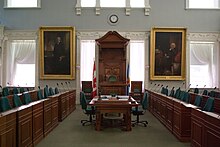Loading AI tools
Unicameral house of the General Assembly of Nova Scotia From Wikipedia, the free encyclopedia
The Nova Scotia House of Assembly (French: Assemblée législative de la Nouvelle-Écosse; Scottish Gaelic: Taigh Seanaidh Alba Nuadh), or Legislative Assembly, is the deliberative assembly of the General Assembly of Nova Scotia, and together with the Lieutenant Governor of Nova Scotia makes up the Nova Scotia Legislature.[1]
Nova Scotia House of Assembly Assemblée législative de la Nouvelle-Écosse | |
|---|---|
| 64th General Assembly of Nova Scotia | |
 | |
| Type | |
| Type | Lower house (1758–1928) then unicameral house of the General Assembly of Nova Scotia |
| Sovereign | The lieutenant governor (representing the King of Canada) |
| History | |
| Founded | 1758 |
| Leadership | |
Leader of Opposition | |
House Leader | |
Opposition House Leader | |
| Structure | |
| Seats | 55 |
 | |
Political groups | Government
Official Opposition Other Parties |
| Elections | |
Last election | August 17, 2021 |
Next election | November 26, 2024 |
| Meeting place | |
 | |
| Legislative Chamber, Province House, Halifax, Nova Scotia, Canada | |
| Website | |
| nslegislature.ca/ | |
The assembly is the oldest in Canada, having first sat in 1758;[2] in 1848, it was the site of the first responsible government in the British Empire. Bills passed by the House of Assembly are given royal assent by the lieutenant governor[3] in the name of the King of Canada.
Originally (in 1758), the Legislature consisted of the Crown represented by a governor (later a lieutenant governor), the appointed Nova Scotia Council holding both executive and legislative duties and an elected House of Assembly (lower chamber). In 1838, the council was replaced by an executive council with the executive function and a legislative council with the legislative functions based on the House of Lords. In 1928, the Legislative Council was abolished and the members pensioned off.
There are 55 Members of the Legislative Assembly (MLAs) representing 55 electoral districts.[4] Members nearly always represent one of the three main political parties of the province: the Nova Scotia Liberal Party, Progressive Conservative Party of Nova Scotia, and Nova Scotia New Democratic Party.
The assembly meets in Province House. Located in Halifax, Province House is a National Historic Site and Canada's oldest and smallest legislative building. It opened on February 11, 1819. The building was also originally home to the Supreme Court of Nova Scotia, and the location of the "Freedom of the Press" trial of Joseph Howe. Its main entrance is found on Hollis Street in Halifax.
A number of officers of the house are appointed in accordance with legislation passed by the house. These officers fulfil numerous functions as prescribed in the relevant legislation. There are two categories of officers:
The Speaker of the House has authority over the following offices and officers:
These include the Auditor General, the Office of the Ombudsman and the Office of the Conflict of Interest Commissioner.[5]
The Chief Electoral Officer of Nova Officer as head of Elections Nova Scotia is also appointed by a majority vote of the house and is considered an officer of the house.
| Affiliation | Members | |
|---|---|---|
| Progressive Conservative | 34 | |
| Liberal | 14 | |
| New Democratic | 6 | |
| Independent | 1 | |
| Vacant | 0 | |
| Total |
55 | |
| Government majority |
+10 | |
(final reports filed)
Current as of October 2024[6]
Seamless Wikipedia browsing. On steroids.
Every time you click a link to Wikipedia, Wiktionary or Wikiquote in your browser's search results, it will show the modern Wikiwand interface.
Wikiwand extension is a five stars, simple, with minimum permission required to keep your browsing private, safe and transparent.